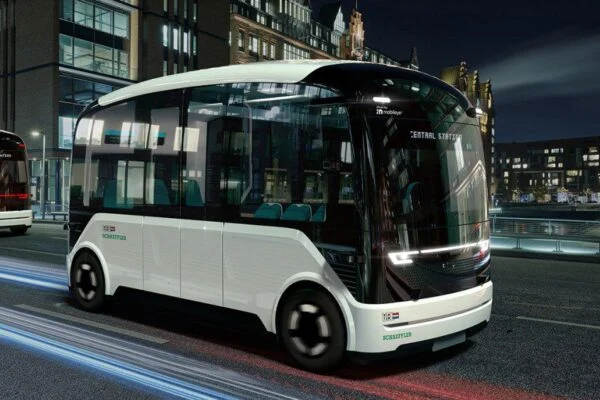Schaeffler and VDL Groep are to show a demonstrator of a self-driving electric shuttle they plan to build together with technology from Mobileye.
The Level 4 self-driving shuttle demonstrator at the IAA Mobility 2023 motor show in Munich will include all the relevant automotive electrification and steering technology.
The two companies are combining their expertise in systems engineering, development, production, and public transport in a strategic deal. VDL Groep is a leading bus manufacturer is the European frontrunner in the electrification of heavy duty vehicles, while Schaffler is an automotive power strain and steering system supplier.
It has introduced a rolling chassis that combines a fully electric powertrain, steer-by-wire system and modular battery.
- Schaeffler equips municipal vehicles with wheel hub drives
- Electromobility switchover forces job cuts at Schaeffler
- Schaeffler boosts software, electronics expertise with R&D
The Mobileye Drive platform designed for shuttle vehicles enables autonomous driving using purpose-built EyeQ processors, redundant sensor systems of surround cameras, and lidar/radar sensing, as well as mapping solutions.
The two are currently in advanced negotiations with public transport authorities and operators to start pilot projects, starting in Germany.
According to the roadmap, testing for the vehicles on the streets will most likely be possible starting in 2025. Target production volumes will depend on achievable sales, but they are projected to produce some thousands of vehicles per year starting in 2030. Production is planned to take place at VDL’s Mobility Innovation Centre in Born in the Netherlands.
Public transport operators are increasingly exploring autonomous driving solutions, allowing for increasing traffic volumes even considering a shortage of drivers. Especially in off-peak hours, larger vehicles would progressively be replaced by smaller, self-driving vehicles based on on-demand services ordered via an app.
Demand for self-driving shuttle services is expected to take off in the coming years, especially in many major cities in Europe, North America, and parts of Asia. The envisaged strategic cooperation between Schaeffler and VDL underlines the early stage engagement to accelerate the development of shuttle vehicles that can be manufactured on a commercial scale.
- Canoo backs Dutch manufacturer for EVs
- CATL expands battery deals in Europe
“Self-driving shuttle vehicles will become integral elements of modern mobility ecosystems. They will bring people safely, quickly, and easily from A to B and increase accessibility to mobility for everyone living in cities and rural areas. We at Schaeffler want to support this development with best-in class systems engineering as well as innovative automotive technology in a sustainable manner. This goal is best realized with strong partners,” said Klaus Rosenfeld, CEO of Schaeffler AG.
“Autonomous shuttles are going to play an important role in our future mobility needs. This vehicle concept fits seamlessly into our broad mobility solution covering design, electrification, connectivity, autonomy, and services. Of course, this planned cooperation is also a fantastic opportunity to pioneer and innovate with our esteemed partners Schaeffler and Mobileye,” said Willem van der Leegte, President and CEO of VDL Groep.
- Mobileye launches first vision-only speed assist system
- MAN partners with Mobileye for self-driving buses
- Porsche picks Mobileye platform for hands-free driving
Johann Jungwirth, Senior Vice President Autonomous Vehicles at Mobileye: “The full potential of autonomous mobility to transform our communities for the better can only be reached if the technologies are safe, accessible, and scalable. Working with Schaeffler and VDL Groep, we have the right strategy and teams to make mobility-as-a-service a reality in the very near future.”
Schaeffler and VDL intend to develop and build the shuttles for public transport operators who will be operating the vehicles within an ecosystem. The companies have already started negotiations with operators to acquire pilot projects with the intention to prove the concept and to set up a scalable ecosystem with open interfaces.
The nine seat shuttles are 5 metres long, 2.2 metres wide, 2.8 metres high and weigh about 5,000 kg. An in-vehicle monitoring system in direct contact to a control room and there are two deeply integrated independent sensing systems: one camera-based and one radar/lidar-based. The maximum speed is 70 km/h and the range is 100km on a single charge, or 350km per day.
www.schaeffler.com; www.vdl.nl; www.mobileye.com



Leave a comment